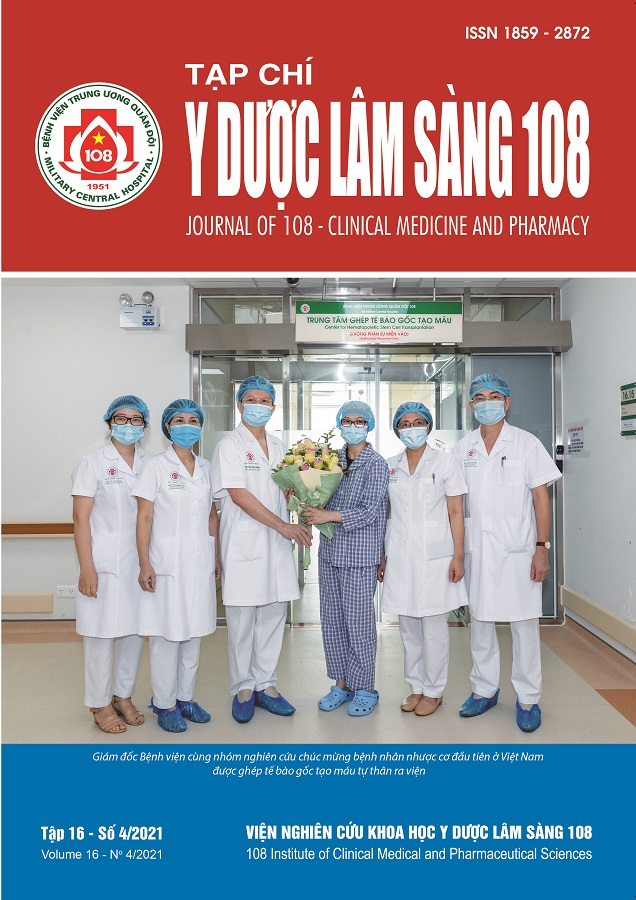Left ventricular-arterial coupling in primary hypertensive patients
Main Article Content
Keywords
Abstract
Objective: To investigate the left ventricular-arterial coupling and its components and the relation with morphology and function of left ventricle and arteries in primary hypertensive patients. Subject and method: In a descriptive study at 103 Military Hospital, Vietnam Military Medical University on 2 groups: A control one consisted of 69 healthy adults without cardiovascular diseases and a hypertensive group of 159 patients. Clinical data, Doppler echocardiography, electrocardiogram and blood pressure (BP) measurements were obtained. Ventricular-vascular coupling (VAC) was defined as Ea/Ees ratio, in which, Ea was calculated from stroke volume and systolic BP and indexed to body size (EaI). Ees was calculated by the modified single-beat method using systolic and diastolic BP, stroke volume and tNd. Result: In the hypertensive patients with left ventricular hypertrophy and with left ventricular dilation, VAC was higher and Ees was lower than those with normal left ventricle. In the patients with heart failure with reduced EF and NYHA IV, Ees was lowest and VAC was highest. Ea in the patients without and with heart failure were equivalent, but significantly higher than those in the control group. The correlation between EDVi and LVMi with Ees was negative and with VAC was positive (r = -0.58, -0.30 and r = 0.27, 0.29 respectively, p<0.05). Ea correlated negatively with EDVi (r= -0.42, p<0.05), but did not correlate with LVMi. The increase of Ea, Ees and VAC had a relation with the decrease of CO and CI (p<0.05). VAC had a positive correlation with BNP (r = 0.4, p<0.05), but Ea and Ees did not. Ees, Ea positively correlated with SVRi (r = 0.34 and 0.49 respectively; p<0.05), but VAC did not.The correlation between Ees and Ea was strong and positive (r = 0.661, p<0.001). Conclusion: In primary hypertensive patients, VAC and its components (Ea and Ees) have relations with arterial function, left ventricular morphology and function, as well as the severity of heart failure. In clinical practice, these parameters could be used to evaluate the cardiovascular function.
Article Details
References
2. Suga H (1971) Theoretical analysis of a left-ventricular pumping model based on the systolic time-varying pressure-volume ratio. IEEE Trans Biomed Eng 18(1): 47-55.
3. Chen CH, Fetics B, Nevo E et al (2001) Noninvasive single-beat determination of left ventricular end-systolic elastance in humans. J Am Coll Cardiol 38(7): 2028-2034.
4. Huỳnh Văn Minh, Phạm Gia Khải, Nguyễn Huy Dung và cộng sự (2008) Khuyến cáo 2008 của Hội Tim mạch học Việt Nam: Chẩn đoán và điều trị tăng huyết áp ở người lớn. Khuyến cáo 2008 về các bệnh lý tim mạch và chuyển hóa, Nhà xuất bản Y Học, Thành phố Hồ Chí Minh, tr. 235-294.
5. Yancy CW, Jessup M, Bozkurt B et al (2013) 2013 ACCF/AHA guideline for the management of heart failure: A report of the American College of Cardiology Foundation/American Heart Association Task Force on Practice Guidelines. J Am Coll Cardiol 62(16): 147-239.
6. Lang RM, Badano LP, Mor-Avi V et al (2015) Recommendations for cardiac chamber quantification by echocardiography in adults: an update from the American Society of Echocardiography and the European Association of Cardiovascular Imaging. J Am Soc Echocardiogr 28(1): 1-39.
7. Borlaug BA, Kass DA (2008) Ventricular-vascular interaction in heart failure. Heart Fail Clin 4(1): 23-36.
8. Cheng HM, Yu WC, Sung SH et al (2008) Usefulness of systolic time intervals in the identification of abnormal ventriculo-arterial coupling in stable heart failure patients. European Journal of Heart Failure 10(12): 1192-1200.
9. Nitenberg A, Antony I, Loiseau A (1998) Left ventricular contractile performance, ventriculoarterial coupling, and left ventricular efficiency in hypertensive patients with left ventricular hypertrophy. Am J Hypertens 11(10): 1188-1198.
10. Asanoi H, Sasayama S, Kameyama T (1989) Ventriculoarterial coupling in normal and failing heart in humans. Circ Res 65(2): 483-493.
11. Lam CS, Roger VL, Rodeheffer RJ et al (2007) Cardiac structure and ventricular-vascular function in persons with heart failure and preserved ejection fraction from Olmsted County, Minnesota. Circulation 115(15): 1982-1990.
12. Bonnie Ky, French B, May Khan A et al (2013) Ventricular-arterial coupling, remodeling, and prognosis in chronic heart failure. J Am Coll Cardiol 62(13): 1165-1172.
13. Mathieu M, Oumeiri B, Touihri K et al (2010) Ventricular-arterial uncoupling in heart failure with preserved ejection fraction after myocardial infarction in dogs - invasive versus echocardiographic evaluation. BMC Cardiovascular Disorders 10: 32-42.
 ISSN: 1859 - 2872
ISSN: 1859 - 2872
